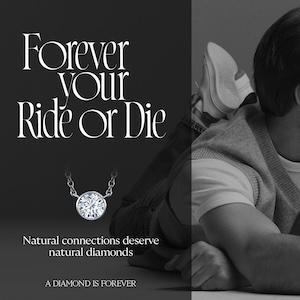
Post-JCK, some are proclaiming that natural diamonds are “back.” And yes, one can spot some small signs of a revival, including a slight improvement in retail sales. But if a turnaround is coming, it’s still in its early stages, and not everyone has seen it yet. (All the “diamond business is in trouble” headlines probably don’t help.)
What is clear is the natural sector now understands the stakes. At JCK, during one roughly 24-hour period, showgoers could attend the Diamonds Do Good dinner, the De Beers breakfast, Botswana President Mokgweetsi Masisi’s “fireside chat” with JCK’s Victoria Gomelsky, and a Natural Diamond Council event featuring Real Housewife Lisa Rinna. That’s four events, staged by four different (if linked) organizations, all promoting natural diamonds. And that’s with Alrosa sitting on the sidelines.
During the De Beers event, CEO Al Cook called the industry’s success in 2021 and 2022 a “burden,” and there’s some truth to that. The COVID-era boom meant huge sales for both lab-grown and natural diamonds. But now, both products are fighting over a smaller pie.
Ideally, the industry would have used lab-grown to expand the overall market. Unfortunately, the two sectors decided to claw each other’s eyes out, and rather predictably, they’ve both been left reeling and damaged. (I sometimes use a LinkedIn test: If people have time to argue about lab-grown versus natural on that platform, chances are, business is bad. Lately, there’s been lots of arguing.)
For all the current lab-grown momentum, marketing appears to have fallen off now that the venture capital money backing many of those brands has dried up. It’s not clear what will drive lab-grown consumer demand going forward, except for perhaps Pandora. (After 10 years, lab-grown still has no industry group.) That leaves natural an opening.
The COVID-era boom may have bred a certain complacency in the natural diamond world. De Beers certainly didn’t prioritize marketing in 2023 the way it’s doing now. Early last year, execs told sightholders that they believed the lab-grown trend had peaked. Instead, it gained traction throughout the year.
It is possible that 2023 will be the peak year as far as LGDs taking natural’s market share. (There’s still plenty of room for lab to grow in fashion, as Signet indicated on its conference call today.) Regardless, created gems aren’t going anywhere. And while many retailers may be nervous about perpetually dropping prices, others say they can carry on selling bigger or better gems for less. Obviously, that can’t go on forever, because not everyone wants 6 ct. earrings, and gross margin dollars have taken a hit. I’ve heard of jewelers who mostly sell lab and would like to diversify but can’t figure out a way because they’re in too deep. There’s a need for an industry-wide roadmap or (re)training module.
Which brings us to De Beers, the stately diamond miner that currently has a rather ugly “for sale” sign hanging on it. For the business to attain maximum value, either as an asset or public company, the troubled miner needs to show market growth.
Executives sometimes call De Beers an unusual company, as its core strengths are “mining and marketing.” (I’d add a third “m” to that: market knowledge.) It’s not unusual for other consumer goods, like pharmaceuticals, to have both technical and marketing divisions. But that’s not common in mining.
It’s certainly possible to imagine a revamped De Beers that’s mostly a miner. It could outsource marketing to the Natural Diamond Council (like platinum miners do with the Platinum Guild), and sell off its noncore businesses, such as De Beers Jewellers and Element Six. It might even sell off its Canadian holdings to Burgundy, and reposition itself as an African company, with mostly African ownership. It could even license its name, see what others could do with it. (Hotels?)
But that’s not the path it’s setting out. Cook seems to be hedging his bets, positioning his company as both a miner and high-end jeweler. “If I look at the future of diamonds, it is way beyond mining,” he told the Financial Times, noting that De Beers hopes to hit 100 jewelry stores by decade’s-end.
I agree with Paul Zimnisky: Cook’s talk about high-end retail is mostly about dressing the company up for sale or an IPO. Taking De Beers Jewellers (DBJ) to 100 stores from its current 40 would be a mighty lift, especially for a chain that’s been around for more than two decades without making much money, while its corporate parent is cutting costs. (Of course, in the end, the new owner will make the call.)

The problem with DBJ is, and always has been, De Beers may stand for diamonds, but De Beers Jewellers stands for…what? If DBJ is going to compete with Tiffany and Cartier, it needs a compelling reason why people should shop at De Beers instead of those two far more established names. What is De Beers’ signature look? Who does its designing? What does miner ownership mean at a consumer level, both as far as price and provenance? (Both Canadian miner Dominion and Gemfields have owned retail brands; the results have been mixed.) Even the “De Beers equals diamonds” positioning is somewhat limiting, as the store can’t branch out into other jewelry staples like colored stones, pearls, and watches.
Yet it’s also difficult to see De Beers remaining just a miner. That’s never been its MO, and it simply has fingers in too many pies. Could another company or organization handle its (promising) “Origin Stories” program, which will likely be the focus of its new polished division? And the De Beers name has value, certainly in the trade. If Signet made a deal with the Natural Diamond Council, that would be news. But Signet joining with De Beers made a splash, as we see from Diamond Foundry’s reaction.
I believe De Beers will find a buyer simply because of its prestige. A company buying Anglo American will make headlines in the financial world. A company that buys De Beers will see its name splashed everywhere.
But when you look at possible buyers, most scenarios seem unappealing. Private equity might load it up with debt and strip it for parts, as those firms do. Going public would mean quarterly reporting, which could be hard on a business built for the long term. A management buyout might work, but does management have the money? A Gulf State sovereign wealth fund could bring all sorts of political complications. A luxury brand isn’t built to run a miner. The name that keeps getting mentioned is the Oppenheimers. But Jonathan’s now in aluminum, and Al Cook laughed when I asked him if they’d ever come back. Certainly, the trade would react favorably, and the family must still feel some bond to the business. (Help us, Nicky-Jon Kenobi. You’re our only hope!) But unless they swoop in, and there’s no indication they will, we’re left with an uncertain and puzzling landscape.
It was just two years ago, when certain retailers began distancing themselves from Alrosa, and the industry was still enjoying the COVID boom, that De Beers had to tell a hungry trade that its mines were maxed out. That was in 2022, when annual sales hit their highest level since 2014. The following year, sales fell 36%. That shows how fast things can change in this business.
Any large-scale pivot to natural probably won’t happen quite so quickly. Most likely, it will require a lot of money, time, and planning. It took a long while for the mined market to lose all the ground that it has. It may also take a while before it gets any back.
Top: Lisa Rinna in front of the Only Natural Diamonds issue featuring her (photo courtesy of the Natural Diamond Council)
Follow JCK on Instagram: @jckmagazineFollow JCK on Twitter: @jckmagazine
Follow JCK on Facebook: @jckmagazine





